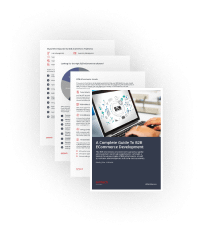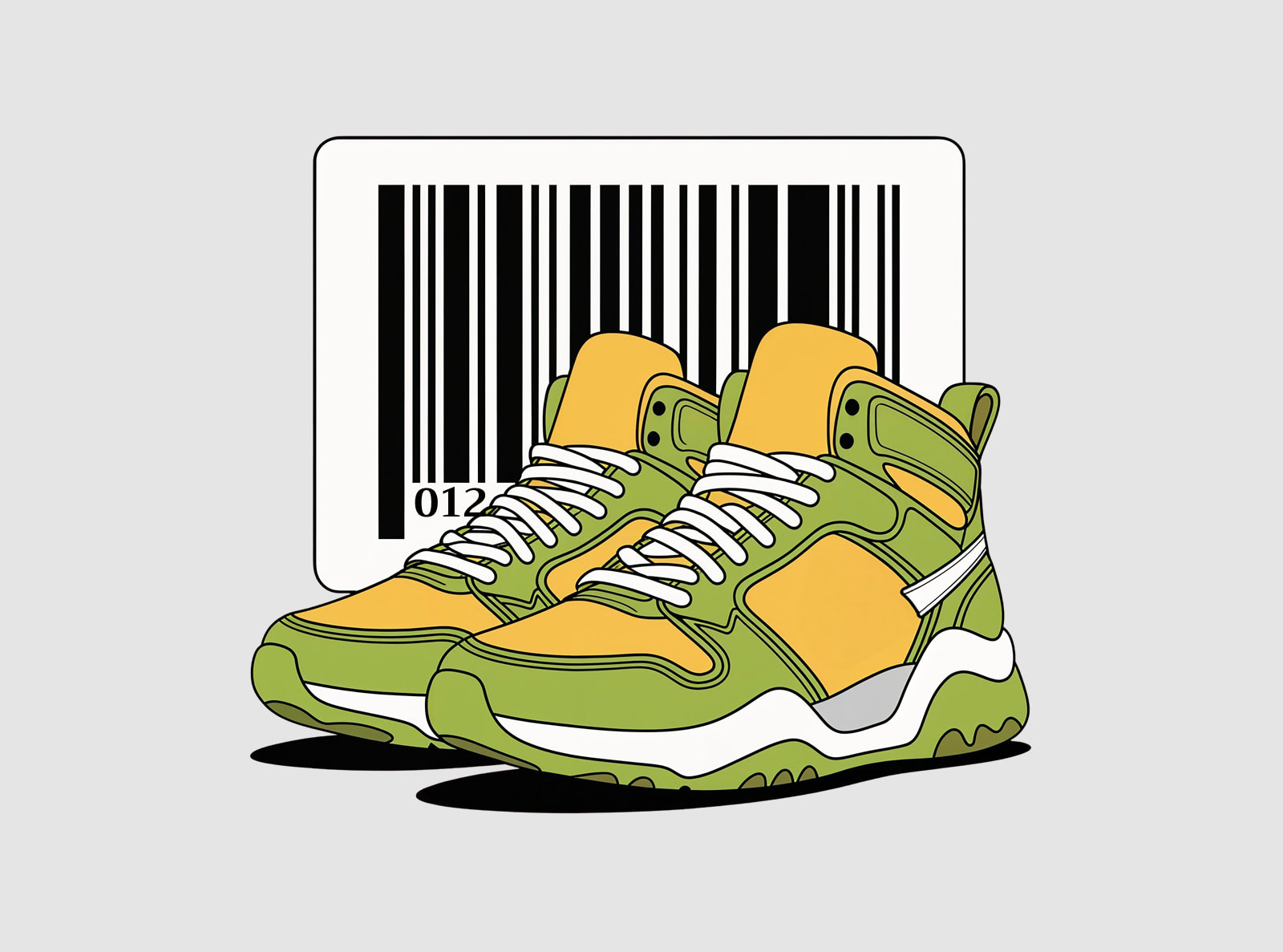If you’ve ever glanced at the back of a product and noticed a string of black lines with numbers underneath, you’ve encountered a UPC barcode. This Universal Product Code is more than just a label—it’s a vital component of how retail systems, ranging from supermarkets to global eCommerce platforms, track inventory, manage product listings, and ensure seamless operations at the point of sale.
What Is a UPC Code?
UPC stands for Universal Product Code, a standardized barcode number used worldwide to identify products sold in retail stores uniquely. It’s a crucial part of the global trade item number (GTIN) system managed by GS1, the international standard that ensures consistency across all markets and supply chain partners.
UPC Meaning in Retail
In the retail industry, UPCs act like digital fingerprints. Whether you’re managing thousands of SKUs in a warehouse or selling online via Shopify, Amazon, or Walmart, UPCs help retailers create streamlined operations by associating one unique UPC with each product variation, including differences in size, color, or packaging.
They’re used for:
- Product tracking across warehouses
- Real-time inventory management
- Ensuring each retailer sells the correct product code
- Enabling accurate barcode reader scans at checkout
Why UPC Codes Are Important for Businesses and Consumers
For businesses, they ensure:
- Inventory tracking made easy. By scanning UPCs, companies can instantly update stock levels and improve supply chain efficiency.
- Better sales data. Each UPC number is tied to your inventory system, providing you with insights into products globally, sales velocity, and reorder needs.
- Marketplace compliance. Major platforms, such as Amazon, require a valid UPC for inventory control and may reject listings without one. Your product might also be matched by its ASIN (Amazon Standard Identification Number) if it shares the same UPC code.
- Barcode compliance. Following GS1 barcode standards ensures your business avoids fines or rejection from resellers.
For consumers, UPCs mean:
- Faster checkouts and fewer errors at the point of sale.
- Confidence in the authenticity of products sold.
- Accurate product information is displayed when scanned with mobile apps (including QR codes for enhanced details).
UPCs serve as a vital link between businesses and consumers, facilitating efficient operations, accurate transactions, and transparent product information.
What Does a UPC Code Look Like?

A standard UPC code consists of 12 digits displayed beneath a series of vertical black bars. These bars represent the numeric code in a machine-readable format, allowing scanners to retrieve product information instantly.
UPC Code Format and Components
The 12-digit UPC is structured as follows:
- Company Prefix
- Item Number
- Check Digit (a mathematically calculated number to prevent errors)
UPC Components Explained
Let’s break down each part of the code:
1. Company Prefix
GS1 assigns this segment. It identifies the brand or manufacturer.
2. Item/Product Number
Assigned by the manufacturer, this number distinguishes individual products and variations.
3. Check Digit
The final digit is generated through a specific formula and acts as a security measure to detect scanning errors.
How to Read a UPC Barcode
Let’s say you’re holding a box of granola bars with the UPC 036000291452:
- 036000 is the manufacturer’s prefix
- 29145 identifies the specific product
- 2 is the check digit, calculated based on the previous 11 digits
This ensures the code is valid and scan-ready.
Difference Between UPC-E and UPC-A barcodes
Apart from the standard version—-UPC-A, there is also its shortened variant—-UPC-E—-primarily differing in length, size, and use cases.
| Feature | UPC-A | UPC-E |
| Digits encoded | 12 digits | 6 digits (plus check and NSD) |
| Barcode size | Full size (larger) | Condensed (about half size) |
| Number system digit | Explicit | Implicit (always 0) |
| Use case | Standard retail packaging | Small packaging with limited space |
| Encoding method | Full numeric code | Zero suppression of zeros in manufacturer/product codes |
| Guard patterns | Start, middle, end | Start and end only (no middle) |
| Check digit | Yes | Yes |
| Numeric only | Yes | Yes |
UPC-E barcodes are used when the packaging size cannot accommodate a complete UPC-A barcode. It achieves this by compressing the UPC-A code through zero suppression, making it ideal for small items without losing the ability to identify the product uniquely. However, UPC-E can only represent UPC-A codes with a certain number system digits (0 or 1) and specific zero patterns, limiting its applicability.
Where Is the UPC Code Located on a Product?
You’ll usually find the UPC printed on the product packaging, often on the back or bottom of the package. For smaller items, it may be located on a tag or sticker.

Read more tips on product page drafting in our articles:
- How to Create the Perfect Product Page For Your Marketplace?
- 7 Steps Towards Better User Experience to Help Customer to Find a Product on Your eCommerce Site
Types of Product Codes: UPC vs. Other Identifiers
While UPC codes are widely used, they’re not the only product identifiers. Let’s look at how UPC compares to other standard codes:
UPC vs. EAN
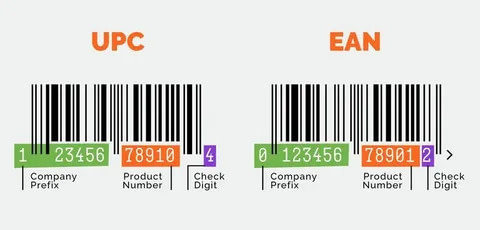
- The EAN (European Article Number) is similar to the UPC, but typically consists of 13 digits. It’s more common outside of North America.
- EAN-13 is compatible with most barcode scanners that support UPC.
Learn more about EANs from our article: EAN Codes: What They Are, How to Get Them, and How to Use Them in eCommerce
UPC vs. SKU

- SKU (Stock Keeping Unit) is an internal identifier used by retailers to track inventory.
- Unlike UPC, SKUs are not standardized and can vary between sellers.
Learn more about SKUs from our article: SKU | What is SKU: Meaning, Examples, How to Use
UPC vs. ASIN
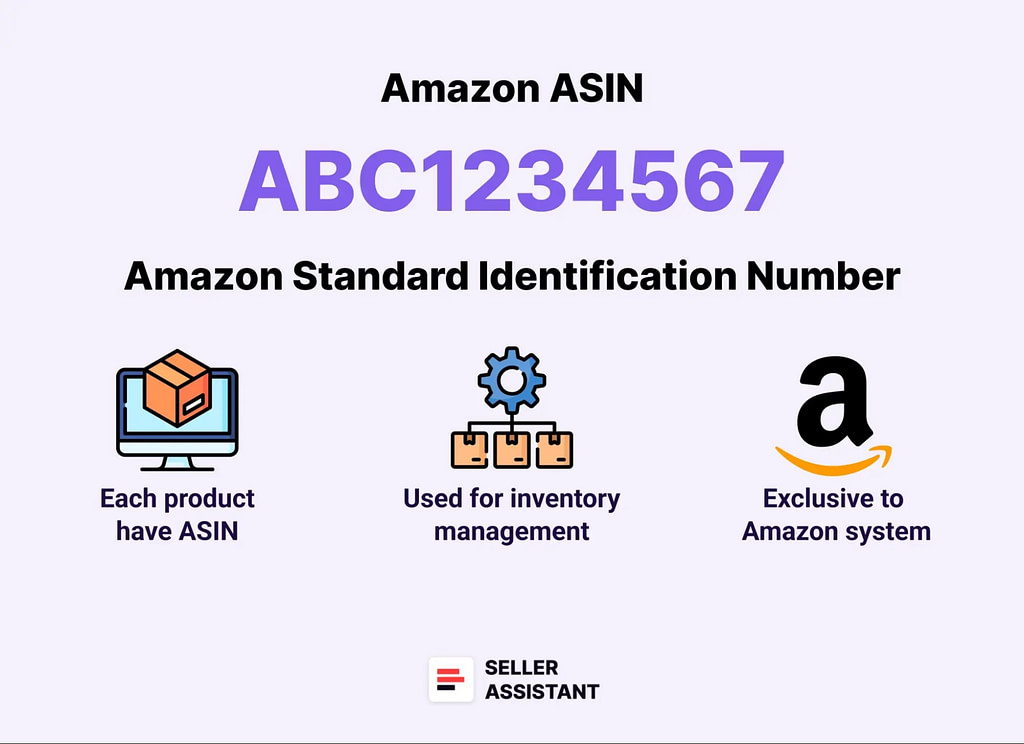
- ASIN (Amazon Standard Identification Number) is unique to Amazon and used to catalog products on its platform.
- A product can have both a UPC and an ASIN.
UPC vs. ISBN
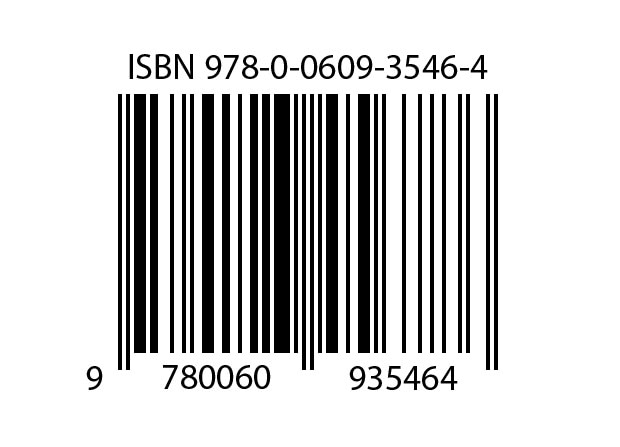
- ISBN is used exclusively for books and is a 10- or 13-digit identifier.
- The publishing industry regulates it and usually replaces a UPC in book sales.
Summary Table of UPC Comparison to Other Product Codes
| Code | Use Case | Standardized | Notes |
| UPC | Retail | Yes (GS1) | 12 digits, used in North America |
| EAN | Global | Yes | 13 digits, used internationally |
| SKU | Internal | No | Custom codes per seller |
| ASIN | Amazon | Yes | Tied to UPC, used on Amazon only |
| ISBN | Books | Yes | Used in publishing industry |
How to Get a UPC Code for Your Products
If you’re selling physical products, especially online, you’ll likely need at least one UPC—if not dozens. Here’s how to start:
How Many UPCs Do You Need?
You’ll need a separate UPC for each unique product and variation. For example, a T-shirt in three sizes and two colors would need 6 different UPCs.
GS1 vs. Resellers
- GS1 is the only official global provider of UPC codes. Buying from GS1 ensures your codes are unique and recognized across major platforms.
- Resellers may offer cheaper options, but they can lead to duplicate or non-compliant codes, especially on Amazon.
Registration and Cost
Getting UPCs from GS1 involves:
- Registering your company prefix
- Assigning product codes
- Paying an initial setup fee + annual renewal based on your product count
Managing and Using UPC Codes in Your Business
Once you have your UPCs, you need to implement them properly across your catalog.
How to Manage UPC Codes in a Product Catalog
Use a spreadsheet or product information management system (PIM) to:
- Track which UPC belongs to which product
- Assign UPCs to variants (color, size, model)
- Keep a backup of all assigned codes
How to Use UPCs for Labeling, Scanning, and Selling Online
- Print barcodes on product packaging
- Use barcode scanners in physical stores or warehouses
- Provide UPCs when listing on marketplaces like Amazon, eBay, Walmart, Google Shopping, or another eCommerce platform
How to Verify a UPC Code
You can verify UPCs through:
- GS1 GEPIR database
- Barcode lookup tools (UPCitemdb.com, Barcode Lookup, and Go-UPC are among the most popular ones)
- Ensuring that the check digit is correct
Common Mistakes to Avoid
- Using the same UPC for different products
- Assigning a UPC that hasn’t been officially purchased
- Forgetting to add UPCs to product variants
UPC Codes in the Modern Retail
UPC codes enable efficient inventory management, order fulfillment, and marketplace integration.
UPC Codes in the Supply Chain
In platforms like CS-Cart, UPCs power accurate stock tracking, warehouse picking, and order fulfillment. They streamline operations by enabling:
- Real-time inventory syncing
- Lower human error in data entry
- Product authentication (crucial in pharmaceuticals and luxury goods)
Marketplace Integration
UPCs are mandatory on major marketplaces for visibility and compliance. Major online marketplaces such as Amazon, Walmart, and Google Shopping require UPCs or other GTINs for product listings to ensure product visibility, trust, and compliance. UPCs serve as a global standard, enabling seamless product tracking and pricing accuracy across various retail and eCommerce platforms. For products with variants (e.g., different sizes or colors), each variant must have its own unique UPC or GTIN to meet marketplace requirements and avoid listing rejections or limited ad performance. If a product lacks a GTIN, sellers may need to apply for exemptions, depending on the marketplace policies. For CS-Cart users targeting Amazon or Google Shopping, unique UPCs per variant are essential to avoid listing rejections or poor ad performance.
Customizing Your Marketplace for Full UPC Support
UPCs are critical for retail efficiency and eCommerce success, but platforms vary in how they support them.
Out of the box, CS-Cart supports product-level UPCs. There is also an eBay add-on enabling you to add all the main product identifiers.

If your business requires variant-level UPCs (e.g., for size or color) for other eCommerce platforms, you’ll need customization.
Simtech Development specializes in upgrading CS-Cart with:
- Variant-level barcode fields
- Marketplace feed compatibility (Amazon, Google Shopping)
- Inventory and warehouse integration
Future Trends: 2D Codes, GTINs, and Beyond
The retail industry is evolving towards enhanced product transparency and supply chain efficiency, driven by advancements in barcode technology and the increasing demand for detailed product information. The industry is shifting to more dynamic formats.
Transition to Dynamic Barcode Formats
One of the most notable trends in retail technology is the widespread adoption of 2D barcodes, such as QR codes. Unlike traditional 1D barcodes that only encode a product’s numeric identifier, 2D barcodes can store significantly more information in a compact space. This expanded capacity allows for embedding critical data such as:
- Batch numbers and production dates, which help with quality control and recall management
- Product origin details, providing transparency about where and how a product was made
- Web links or URLs that direct consumers to rich digital content, including product certifications, usage instructions, or promotional offers
This enhanced data capability empowers both retailers and consumers with deeper insights into the product lifecycle and authenticity.
GS1’s Project Sunrise: A Global Shift to 2D QR Codes
Recognizing the potential of 2D barcodes, GS1 has launched Project Sunrise. This initiative aims to transition the retail industry from traditional linear barcodes to 2D QR codes on a global scale by 2027. The project focuses on:
- Standardizing QR code usage across markets and product categories
- Ensuring interoperability of scanning technologies worldwide
- Facilitating the integration of richer product data into supply chains
Project Sunrise is expected to revolutionize how products are identified and traced, enabling a more connected and transparent retail ecosystem.
Emergence of Digital Product Passports
Another innovative development reshaping retail transparency is the concept of digital product passports. These are digital records linked to individual products that store comprehensive information about:
- Sourcing of raw materials, ensuring ethical and sustainable procurement
- Manufacturing processes, including environmental impact and labor conditions
- Recycling and end-of-life instructions, promoting circular economy principles
- Regulatory compliance data, ensuring products meet safety and legal standards
Digital product passports empower consumers to make informed purchasing decisions and support brands in demonstrating accountability and sustainability.
Smart Labels: Combining RFID and QR Codes for Enhanced Traceability
To further enhance supply chain visibility, the industry is increasingly adopting smart labels that combine RFID (Radio Frequency Identification) technology with QR codes. This hybrid approach offers multiple advantages:
- RFID enables rapid, contactless scanning of multiple items simultaneously, improving inventory management and reducing errors
- QR codes provide detailed product information accessible to consumers and supply chain partners via smartphones
- Together, they create a robust traceability system that tracks products from manufacture to point of sale and beyond
Smart labels enable real-time monitoring, facilitate anti-counterfeiting measures, and enhance logistics efficiency.
Conclusion: Upgrade Your Retail Tech Stack with Simtech Development
Online commerce is evolving rapidly: UPC and other product identifiers will further penetrate product management for trustworthy product listings. Whether you’re selling on global platforms or managing inventory across multiple warehouses, aligning with the modern requirements is critical.
But not all eCommerce platforms support advanced features out of the box.
That’s where Simtech Development comes in.
As an official CS-Cart partner, Simtech Development assists online retailers and marketplace owners in customizing their platforms. For complete UPC support, we can include variant-level UPCs, barcode-based warehouse automation, and integrations with Amazon, Google Shopping, and eBay.
From adding custom barcode fields to building fully automated inventory workflows, Simtech’s team ensures your marketplace runs with the same precision and compliance as the world’s top retailers.
